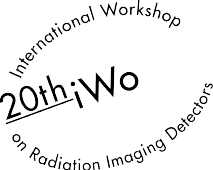Speaker
Description
In this study, we used a novel type of 500um-pitch SiPM to develop a high resolution small animal DOI-PET detector. This SiPM has a very fast recovery time (~8ns) and high gain (10^6). The signal was read from both ends of the GAGG scintillator (0.4mm0.4mm20mm) to obtain the DOI information. According to the simulation based on GEANT4, the spatial resolution of the small animal DOI-PET system can be improved to ~0.64mm.
1.Introduction
Positron emission tomography (PET) is a nuclear imaging technique that can be used to visualize metabolic processes in the body by measuring the concentration of molecular probes labelled with positron-emitting radionuclides.At present, the resolution of PET imaging is sub-millimeter. Pixel size and parallax error are considered as two of the factors that limit spatial resolution. By using smaller photosensors and applying DOI (depth of interaction) estimation, effects of these factors can be reduced. Dual-sided readout detectors is a common approach for DOI measurement. The DOI information of a dual-sided readout detector is a function of the ratio of energy deposition in one SiPM array (E1) and the total energy deposition in both of the SiPM arrays (Etotal=E1+E2).
2.Materials and Methods
2.1.GEANT4 Simulation
We simulated single pixel to find the relationship between DOI and energy deposition ratio (E1/Etotal). The scintillator was 0.4mm×0.4mm×20mm Gd3Al2Ga3O12 (GAGG) wrapped by reflector (BaSO4). And each end of the crystal had a SiPM. We let the gamma rays irradiate the crystal at different DOI and record energy deposition in the SiPMs. We also simulated the whole ring system to evaluate its spatial resolution. The PET system consisted of 8 detector modules and each module had 80×80 pixels. The inner diameter of the detector ring was ~98mm.
2.2.Experiment
A novel type of SiPM [1] which is very compact (500um pitch), has very fast recovery time (~8ns) and high gain (10^6) was used to develop the detector. A 0.4mm×0.4mm×20mm GAGG scintillator was placed between two SiPM and fixed by a supporter. After filtering and amplifying, signals were readout by a time-over-threshold (ToT) ASIC.
3.Result
The simulation result showed that the relationship between DOI and E1/Etotal is linear and DOI resolution at the center of the crystal (10mm) was ~0.76mm. The spatial resolution of the PET system can be improved to ~0.64mm. In the real experiment, a very small peak of 511keV can be seen from the spectra.
4.Future Work
In the future, we will calibrate DOI in the real experiment, and evaluate DOI resolution.
Reference:
[1] A. Koyama. Fabrication and Characterization of a 500-µm-Pitch 64-Channel Silicon Photomultiplier Prototype[J]. 2017.




